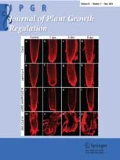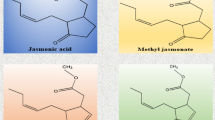Abstract
Although gibberellins (GAs) have been shown to induce development of the physiological disorder blossom-end rot (BER) in tomato fruit (Solanum lycopersicum), the mechanisms involved remain largely unexplored. BER is believed to result from calcium (Ca) deficiency, but the relationship between Ca content and BER incidence is not strong. Our objectives were to better understand how GAs and a GA biosynthesis inhibitor affect BER development in tomato fruit. Tomato plants of two BER-susceptible cultivars, ‘Ace 55 (Vf)’ and ‘AB2,’ were grown in a greenhouse environment and subjected to Ca-deficiency conditions. Plants were treated weekly during fruit growth and development with 300 mg L−1 GA4+7, 300 mg L−1 prohexadione-calcium (Apogee®, a GA biosynthesis inhibitor), or water beginning 1 day after flower pollination. GA4+7 treatment induced an increase in BER incidence in both cultivars up to 100%, whereas ‘Ace 55 (Vf)’ and ‘AB2’ plants treated with Apogee did not show BER incidence. The number of functional xylem vessels was higher in the placental and pericarp tissue of tomato fruit treated with Apogee at the early stages of fruit growth. Treatment with Apogee also increased fruit pericarp Ca concentration. GA4+7 treatment enhanced the expression of the putative CAX and Ca-ATPase genes, that code for proteins involved in Ca movement into storage organelles. The lowest water-soluble apoplastic Ca concentration and the highest membrane leakage values were observed in the pericarp of GA4+7-treated fruit. These results suggest that GAs consistently reduced fruit Ca uptake and water-soluble apoplastic Ca concentration, leading to leakier plasma membranes and an increase in BER development in fruit tissue of both tomato cultivars.










Similar content being viewed by others
References
Almeida DPF, Huber DJ (1999) Apoplastic pH and inorganic ion levels in tomato fruit: a potential means for regulation of cell wall metabolism during ripening. Physiol Plant 105:506–512
Aloni R (2001) Foliar and axial aspects of vascular differentiation: hypotheses and evidence. J Plant Growth Regul 20:20–22
Bangerth F (1973) Investigations upon Ca related physiological disorders. Phytopathol Z 77:20–37
Barlow PW, Brain P, Parker JS (1991) Cellular growth in roots of a gibberellin-deficient mutant of tomato (Lycopersicon esculentum Mill.) and its wild-type. J Exp Bot 42:339–351
Bergevin M, L’Heureux GP, Thompson JE, Willemot C (1993) Effect of chilling and subsequent storage at 20°C on electrolyte leakage and phospholipid fatty acid composition of tomato pericarp. Physiol Plant 87:522–527
Bidadi H, Yamaguchi S, Asahina M, Satoh S (2010) Effects of shoot-applied gibberellin/gibberellin-biosynthesis inhibitors on root growth and expression of gibberellin biosynthesis genes in Arabidopsis thaliana. Plant Root 4:4–11
Bush DS, Biswas AK, Jones RL (1989) Gibberellic-acid-stimulated Ca2+ transport and steady-state levels. Planta 178:411–420
Butcher DN, Street HE (1960) The effect of gibberellins on the growth of excised tomato roots. J Exp Bot 11:206–216
Castro PRC (1980) Plant growth regulators in tomato crop production. Acta Hortic 100:99–104
Chen X, Chang M, Wang B, Wu R (1997) Cloning of a Ca2+-ATPase gene and the role of cytosolic Ca2+ in the gibberellin-dependent signaling pathway in aleurone cells. Plant J 11:363–371
Cheng NH, Pittman JK, Shigaki T, Lachmansingh J, LeClere S, Lahner B, Salt DE, Hirschi KD (2005) Functional association of Arabidopsis CAX1 and CAX3 is required for normal growth and ion homeostasis. Plant Physiol 138:2048–2060
Cooley MB, Yang H, Dahal P, Mella RA, Downie AB, Haigh AM, Bradford KJ (1999) Vacuolar H-ATPase is expressed in response to gibberellin during tomato seed germination. Plant Physiol 121:1339–1347
Cuartero J, Fernández-Muñoz R (1999) Tomato and salinity. Sci Hortic 78:83–125
De Freitas ST, Padda M, Wu Q, Park S, Mitcham E (2011) Dynamic alterations in cellular and molecular components during blossom-end rot development in tomatoes expressing sCAX1, a constitutively active Ca2+/H+ antiporter from Arabidopsis. Plant Physiol 156(2):844–855
Drazeta L, Lang A, Hall AJ, Volz RK, Jameson PE (2004) Causes and effects of changes in xylem functionality in apple fruit. Ann Bot 93:275–282
Ebert A, Bangerth F (1985) Veränderungen im Phytohormongehalt und mögliche Beziehungen zur Fruchtentwicklung beim Apfel. Gartenbauwissenschaft 50:37–41
El-Beltagy AS, Patrick JP, Hewitt EW, Hall MA (1976) Endogenous plant growth regulator levels in tomato fruits during development. J Hortic Sci 51:15–30
Epstein E (1961) The essential role of calcium in selective cation transport by plant cells. Plant Physiol 36:437–444
Ericsson T (1995) Growth and shoot: root ratio of seedlings in relation to nutrient availability. Plant Soil 169:205–214
Ferguson IB, Watkins CB (1989) Bitter pit in apple fruit. Hortic Rev 11:289–355
Fu DQ, Zhu BZ, Zhu HL, Jiang WB, Luo YB (2005) Virus-induced gene silencing in tomato fruit. Plant J 43:299–308
Fu DQ, Zhu BZ, Zhu HL, Zhang HX, Xie YH, Jiang WB, Zhao XD, Luo YB (2006) Enhancement of virus-induced gene silencing in tomato by low temperature and low humidity. Mol Cells 21:153–160
Gillaspy G, Ben-David H, Gruissem W (1993) Fruits: a developmental perspective. Plant Cell 5:1439–1451
Gilroy S, Jones RL (1992) Gibberellic acid and abscisic acid coordinately regulate cytoplasmic calcium and secretory activity in barley aleurone protoplasts. Proc Natl Acad Sci USA 89:3591–3595
Hanson JB (1960) Impairment of respiration, ion accumulation, and ion retention in root tissue treated with ribonuclease and ethylenediamine tetraacetic acid. Plant Physiol 35:372–379
Hirschi KD (1999) Expression of Arabidopsis CAX1 in tobacco: altered calcium homeostasis and increased stress sensitivity. Plant Cell 11:2113–2122
Hirschi KD, Zhen RG, Cunningham KW, Rea PA, Fink GR (1996) CAX1, an H+/Ca2+ antiporters from Arabidopsis. Proc Natl Acad Sci USA 93:8782–8786
Ho LC, White PJ (2005) A cellular hypothesis for the induction of blossom-end rot in tomato fruit. Ann Bot 95:571–581
Ho LC, Adams P, Li XZ, Shen H, Andrews J, Xu ZH (1995) Responses of Ca-efficient and Ca-inefficient tomato cultivars to salinity in plant growth, calcium accumulation and blossom-end rot. J Hortic Sci 70:909–918
Jiang CZ, Lu F, Imsabai W, Meir S, Reid MS (2008) Silencing polygalacturonase expression inhibits tomato petiole abscission. J Exp Bot 59:973–979
Kamiya T, Akahori T, Ashikari M, Maeshima M (2006) Expression of the vacuolar Ca2+ exchanger, OsCAX1a, in rice: cell and age specificity of expression, and enhancement by Ca2+. Plant Cell Physiol 47:96–106
Kirby EA, Pilbeam DJ (1984) Calcium as a plant nutrient. Plant Cell Environ 7:397–405
Knoche M, Peschel S (2007) Gibberellins increase cuticle depositions in developing tomato fruit. Plant Growth Regul 51:1–10
Liu Y, Schiff M, Dinesh-Kumar SP (2002) Virus-induced gene silencing in tomato. Plant J 31:777–786
Marschner H, Kirkby E, Cakmak I (1996) Effect of mineral nutritional status on shoot-root partitioning of photoassimilates and cycling of mineral nutrients. J Exp Bot 47:1255–1263
Martinelli F, Uratsu SL, Reagan RL, Chen Y, Tricoli D, Fiehn O, Rocke M, Gasser CS, Dandekar AM (2009) Gene regulation in parthenocarpic tomato fruit. J Exp Bot 60:3873–3890
Meyer GA, Keliher PN (1992) An overview of analysis by inductively coupled plasma-atomic emission spectrometry. In: Montaser A, Golightly DW (eds) Inductively coupled plasmas in analytical atomic spectrometry. VCH Publishers, New York, pp 473–516
Nelson T, Dengler N (1997) Leaf vascular pattern formation. Plant Cell 9:1121–1135
Nonami H, Fukuyama T, Yamamoto M, Yang L, Hashimoto Y (1995) Blossom-end rot of tomato plants may not be directly caused by calcium deficiency. Acta Hortic 396:107–114
Park S, Kim CK, Pike LM, Smith RH, Hirschi KD (2004) Increased calcium in carrots by expression of an Arabidopsis H+/Ca2+ transporter. Mol Breed 14:275–282
Park S, Cheng NH, Pittman JK, Yoo KS, Park J, Smith RH, Hirschi KD (2005a) Increasing calcium levels and prolonged shelf live in tomatoes expressing Arabidopsis H+/Ca2+ transporters. Plant Physiol 139:1194–1206
Park S, Kang TS, Kim CK, Han JS, Kim S, Smith RH, Pike LM, Hirschi KD (2005b) Genetic manipulation for enhancing calcium content in potato tuber. J Agric Food Chem 53:5598–5603
Pauls KP, Chambers JA, Dumbroff EB, Thompson JE (1982) Perturbation of phospholipid membranes by gibberellins. New Phytol 91:1–17
Pelloux J, Rusterucci C, Mellerowicz EJ (2007) New insights into pectin methylesterase structure and function. Trends Plant Sci 12:267–277
Picchioni GA, Watada AE, Conway WS, Whitaker BD, Sams CE (1998) Postharvest calcium infiltration delays membrane lipid catabolism in apple fruit. J Agric Food Chem 46:2452–2457
Plieth C (2001) Plant calcium signaling and monitoring: pros and cons and recent experimental approaches. Protoplasma 218:1–23
Reynolds JF, Thornley JHM (1982) A shoot:root partitioning model. Ann Bot 49:585–597
Sachs T (2000) Integrating cellular and organismal aspects of vascular differentiation. Plant Cell Physiol 41:649–656
Saltveit ME (2002) The rate of ion leakage from chilling-sensitive tissue does not immediately increase upon exposure to chilling temperatures. Postharvest Biol Technol 26:295–304
Saure MC (2001) Blossom-end rot of tomato (Lycopersicon esculentum Mill.)—a calcium- or a stress-related disorder? Sci Hortic 90:193–208
Saure MC (2005) Calcium translocation to fleshy fruit: its mechanism and endogenous control. Sci Hortic 105:65–89
Sjut V, Bangerth F (1983) Induced parthenocarpy—a way of changing the levels of endogenous hormones in tomato fruit (Lycopersicon esculentum Mill.) 1. Extractable hormones. Plant Growth Regul 1:243–251
Sperry WJ, Davis JM, Sanders DC (1996) Soil moisture and cultivar influence cracking, blossom-end rot, zippers, and yield of staked fresh-market tomatoes. HortTechnology 6:21–23
Suzuki K, Takeda H, Egawa Y (2000) Morphological aspects of blossom-end rot fruits of tomato. Acta Hortic 511:257–264
Suzuki K, Shono M, Egawa Y (2003) Localization of calcium in the pericarp cells of tomato fruits during the development of blossom-end rot. Protoplasma 222:149–156
Ubeda-Tomas S, Swarup R, Coates J, Swarup K, Laplaze L, Beemster GTS, Hedden P, Bhalerao R, Bennett MJ (2008) Root growth in Arabidopsis requires gibberellin/DELLA signaling in the endodermis. Nat Cell Biol 10:625–628
Ubeda-Tomas S, Federici F, Casimiro I, Beemster GTS, Bhalerao R, Swarup R, Doerner P, Haseloff J, Bennett M (2009) Gibberellin signaling in the endodermis controls Arabidopsis root meristem size. Curr Biol 19:1194–1199
Welti R, Li W, Li M, Sang Y, Biesiada H, Zhou HE, Rajashekar CB, Williams TD, Wang X (2002) Profiling membrane lipids in plant stress responses. J Biol Chem 277:31994–32002
White PJ, Broadley MR (2003) Calcium in plants. Ann Bot 92:487–511
Wood A, Paleg LG (1972) The influence of gibberellic acid on the permeability of model membrane systems. Plant Physiol 50:103–108
Zhang C, Lee U, Tanabe K (2008) Hormonal regulation of fruit set, parthenogenesis induction and fruit expansion in Japanese pear. Plant Growth Regul 55:231–240
Acknowledgments
The authors recognize support from CAPES Foundation, a federal agency under the Ministry of Education of Brazil, and the Fulbright Program, which awarded a Scholarship to PhD student Sergio Tonetto de Freitas for his work on this project. We also thank the California League of Food Processors and the California Tomato Research Institute for partial funding of this project.
Author information
Authors and Affiliations
Corresponding author
Rights and permissions
About this article
Cite this article
de Freitas, S.T., Jiang, CZ. & Mitcham, E.J. Mechanisms Involved in Calcium Deficiency Development in Tomato Fruit in Response to Gibberellins. J Plant Growth Regul 31, 221–234 (2012). https://doi.org/10.1007/s00344-011-9233-9
Received:
Accepted:
Published:
Issue Date:
DOI: https://doi.org/10.1007/s00344-011-9233-9




